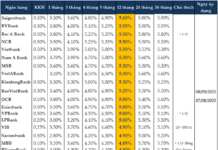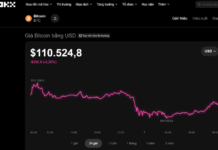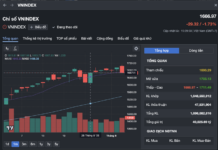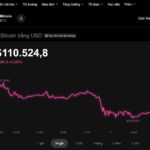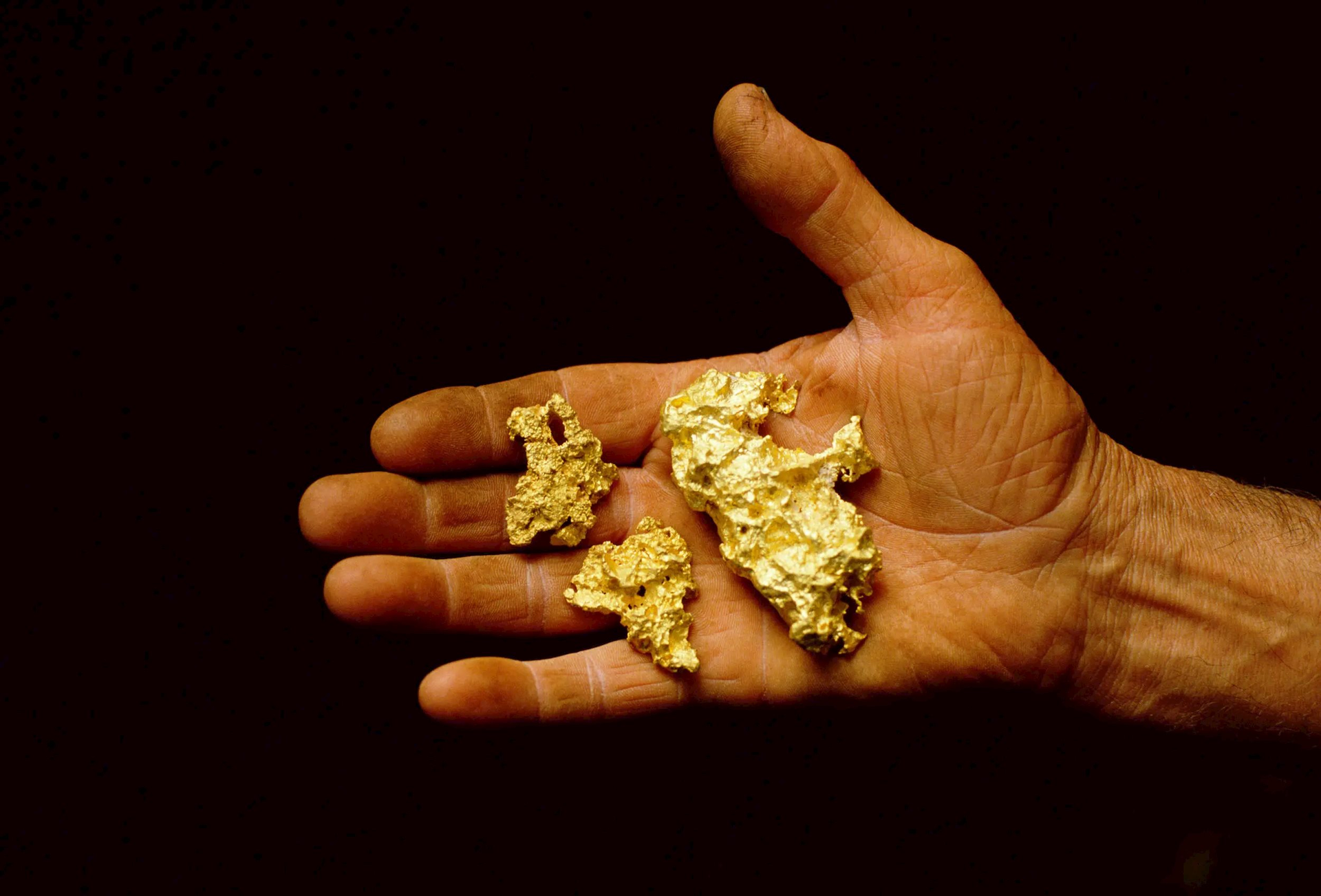
Gold prices witnessed a sharp decline this week, marking the biggest drop in over five months due to a stronger US dollar and predictions surrounding the potential impact of Donald Trump’s event on future US interest rates.
Spot gold ended the week at $2,684.03 an ounce, while December 2024 gold futures settled at $2,694.80.
Domestic gold prices also experienced a significant drop. SJC gold bars on Saturday (Nov 9) were quoted at 82-86 million VND/tael (buy-sell), compared to 87.5-89.5 million VND/tael a week ago. Meanwhile, SJC 9999 gold rings decreased to 83.32-85.15 million VND/tael, down from 83.32-85.12 million VND/tael in the previous week.
The Dollar Index, measuring the US dollar against a basket of its major peers, climbed 0.6% this week.
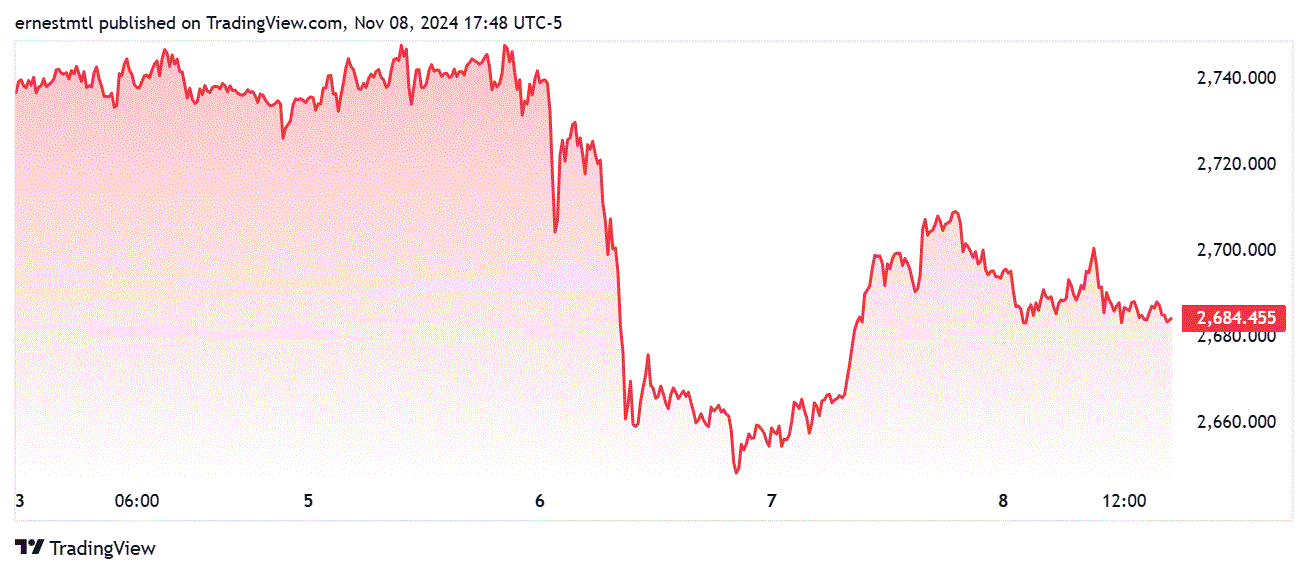
Gold price movement this week
“Over the past month, the narrative has revolved around the risks and uncertainties of the election, and whether the transition would normalize,” said Alex Ebkarian, executive director at Allegiance Gold. “But this election seems to be decisive for the White House.”
“Many risk assets started to benefit from the potential impact of future policies, so we took money off the table from metals and rotated into those alternatives,” Ebkarian Gold added.
The US Federal Reserve (Fed) cut interest rates by 25 basis points on Thursday (Nov 7) but indicated caution in further reductions.
Trump’s victory has raised questions about whether the Fed can continue to cut rates at a slower and smaller pace than expected, given the former president’s tariff policies, although Fed Chair Jerome Powell stated that the election outcome would have no “direct impact” on monetary policy in the “near term.”
The prospect of rate cuts, starting with a half-point reduction in September, has supported gold’s record-breaking rally this year. While bullion is considered an inflation hedge, higher interest rates diminish the appeal of non-yielding gold and vice versa.
“If the market restores the odds of the Fed cutting rates once more before Christmas… that should help keep spot gold prices above the psychological $2,700 level,” said Han Tan, chief market analyst at Exinity Group.
The Kitco News survey showed a predominantly bearish outlook among industry experts, while retail traders also turned pessimistic for the first time in months.
“Prices will go down,” said Darin Newsom, a senior analyst at Barchart.com. “While I think investors will return to gold for long-term risk hedging, the December contract has yet to finish its short-term downtrend. This opens the door for a new round of selling early next week.”
David Morrison, senior market analyst at Trade Nation, stated that the technical picture suggests gold prices will continue to fall.
“Gold prices fell on Wednesday (Nov 6) as it became clear that Trump had won a second term as US president. Much of the gold sell-off can be blamed on the US dollar, which soared on this news, with the USD boosted by a sharp rise in bond yields as investors worried that the tariffs and tax cuts Trump has promised will lead to a resurgence of inflation,” Morrison said.
Since the election outcome, the dollar and yields have returned to more reasonable levels, according to Morrison. “This has helped gold find a bottom and stage a mild rally on Thursday (Nov 7). But the rally ended in the early hours of Friday (Nov 8), and gold once again came under selling pressure. The current support level is $2,635-$2,675. This was the resistance level in the last week of September and early October. Gold tried to push above $2,700 on Thursday evening but failed to hold this level as support. Instead, prices fell during the Asia-Pacific trading session until finding support around $2,680.”
“Prices will go down,” said Adam Button, currency strategy director at Forexlive.com. “I thought prices might go sideways after the election, but I’ll be watching closely for signs of who the next Treasury Secretary will be. In previous elections, Trump announced Mnuchin on Nov 29, and Biden chose Yellen on Nov 23, so the upcoming announcement is probably not next week but soon. If the choice is John Paulson – a big gold price speculator – then I expect gold to rally.”
“Gold will rise,” said James Stanley, senior market strategist at Forex.com. “It looked like gold prices would fall after the election, but the reaction since then has been quite positive, with bulls defending the $2,650 spot and pushing prices to $2,700. Typically with that move, I’d start to lean towards a bearish bias, but given how strong gold has been this year, I’m not yet ready to believe in a trend reversal, so I remain bullish.”
“It will go down,” said Adrian Day, president of Adrian Day Asset Management. “Gold’s continued decline would not be a bad thing, as some investors are still taking profits even as both central banks and Chinese consumers are buying less than previous highs. However, the motivation for all these different buyers remains: the desire to diversify away from dollar dependence for some central banks, as well as China’s concerns about its economy and banks, remain unchanged, while it is clear that the Fed and other central banks will continue to ease policy in the face of a slowing economy, even before inflation is completely extinguished, against a backdrop of high budget deficits with no prospect of control.”
“Remember that gold had a similar reaction to Donald Trump’s election in 2016, also based on optimism about economic growth, a strong dollar, and a strong stock market,” Day added. “At that time, the retreat lasted about six weeks.”
Frank Sohlleder, an analyst at ActivTrades, also believes that gold is likely to see further declines in the coming weeks. “Despite the upward trend, gold has not been able to escape the risk of a major correction,” he said. “Even the cut in key US interest rates could not guarantee strong demand for gold. Therefore, it is still assumed that gold prices may continue to fall. Gold is currently trading at around $2,680 an ounce.”
“Down,” said Mark Leibovit, publisher of VR Metals/Resource Letter. “Trump’s success in the Middle East could slow gold’s upward momentum – which has risen in recent times due to conflicts. True, there are other reasons, and overall, my next big target of $3,700 remains unchanged, but I don’t have a specific timeline for that target at the moment.”
“In summary, we’re about to see a price drop,” he added. “The best strategy I’ve used is to maintain core long positions and hedge against risk using inverse gold and silver ETFs like GLL and ZSL.”
Colin Cieszynski, chief market strategist at SIA Wealth Management, explained the short- and medium-term impacts of the election on gold. He attributed much of gold’s decline on Tuesday night to the diminishing risks of election-related turmoil.
“I think what happened is that gold was priced to the 2000 scenario,” he said. “After that, when there was a decisive winner – to some extent, it doesn’t matter who, just that there’s a winner – a certain amount of event risk was removed. Less than a month ago, gold was at $2,600. Currently, gold is at $2,680, and the peak was around $2,780, so essentially, the increase has been from $2,600 to $2,780, and we’ve given back about half of that gain.”
The second factor Cieszynski cited was the US dollar, which strengthened following Trump’s victory, exacerbating the gold sell-off.
“The US dollar has been very strong,” he said. “The US dollar is the enemy of gold, and the US dollar has also had a rally, but that could also be the same underlying cause. The removal of election uncertainty boosted the US dollar and knocked gold down. So, it’s not that ‘gold is down because the dollar is up,’ it’s that ‘gold is down AND the dollar is up’ because of this other event.”
“The inflation scenario probably won’t change much,” he added, “especially if [Trump] does indeed impose tariffs, which could be inflationary.”
The third factor Cieszynski believes could alter gold’s recent trajectory is the Fed returning to rate cuts.
“Looking at the medium term, one of the fundamental drivers of this gold rally has been central banks starting to cut interest rates,” he said. “They’ve been cutting quite frequently, and in some cases, quite aggressively. That could slow down. This is the first week we’re starting to hear rumors that the Fed might skip a meeting. Even last week, there were no such rumors. The Bank of Canada is still going full throttle, and some other banks are still cutting quite aggressively.”
This has devalued paper money and boosted the value of gold. “But if the situation starts to become one where central banks start to slow down the pace of rate cuts, that’s also a headwind for gold,” he said. “I think gold could go sideways for a while, which is normal.”
“I don’t fully believe that it will have a major correction,” Cieszynski added. “I don’t think it will go back to $2,000 or anything like that. Maybe $2,500, it could test $2,500 again.”
Turning to the short term, Cieszynski expects gold to face strong headwinds next week.
“I’m actually going to be bearish for next week,” he said. “The reason I say that is that gold has had a big rally, and technically, it’s due for a correction. It may not be a major correction, but I think gold could struggle for another week.”
Fourteen analysts participated in the Kitco News Gold Survey, and the sharp sell-off this week left most Wall Street professionals predicting lower gold prices in the week ahead. Only three analysts, or 21%, called for gold to rise in the week ahead, while nine analysts, or 64%, predicted that gold would fall. The remaining two analysts, or 14%, saw a sideways market for gold.
Meanwhile, out of 249 votes cast in the Kitco News online Main Street poll, 114 respondents, or 46%, predicted that gold would rise next week. Meanwhile, 91 people, or 36%, expected prices to fall, and 44 people, or 18%, were neutral on prices.

Kitco News survey results
Reference: Kitco News







